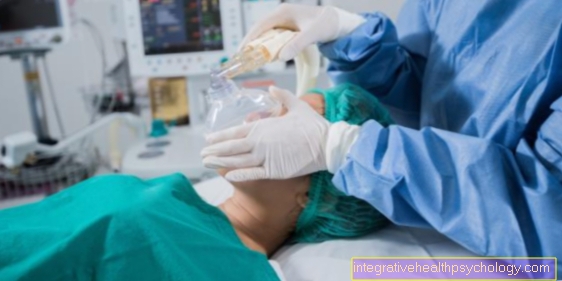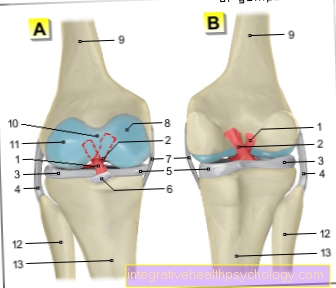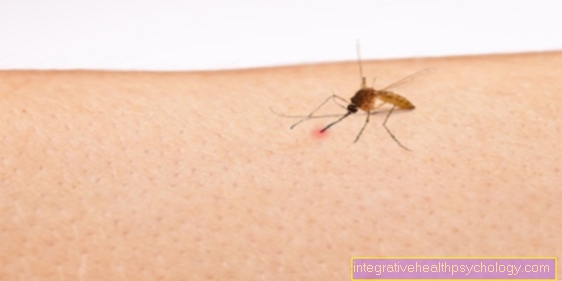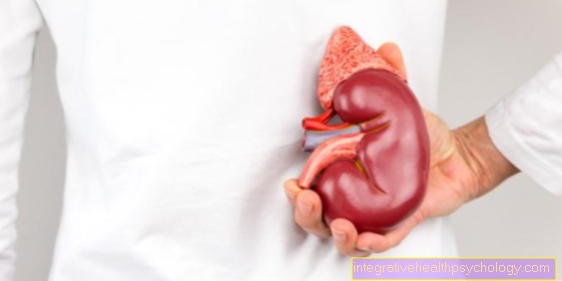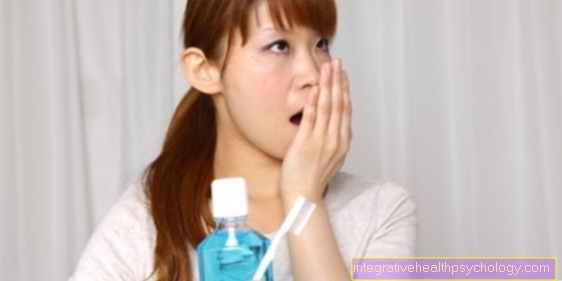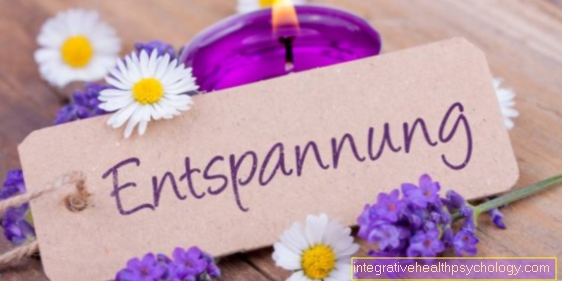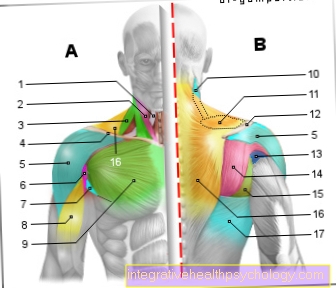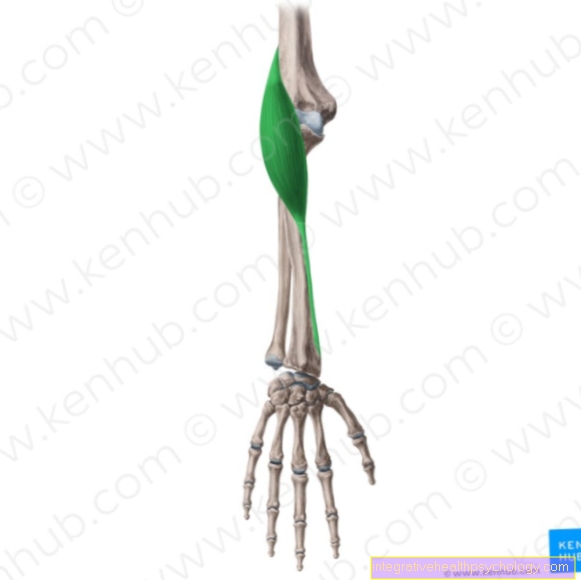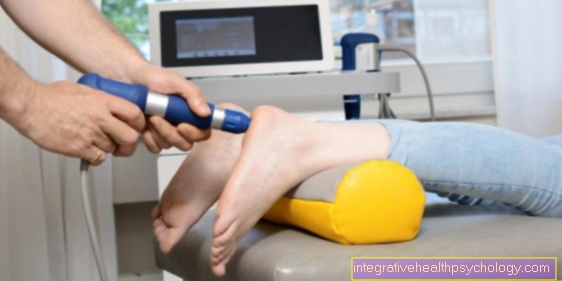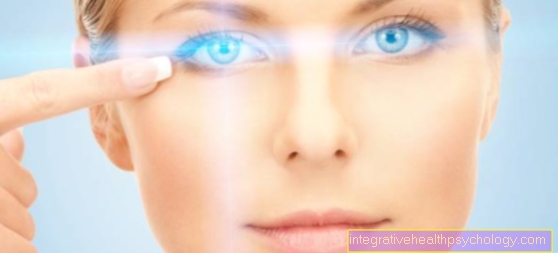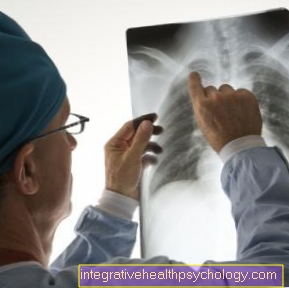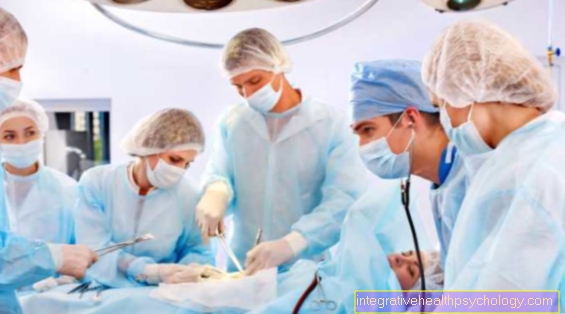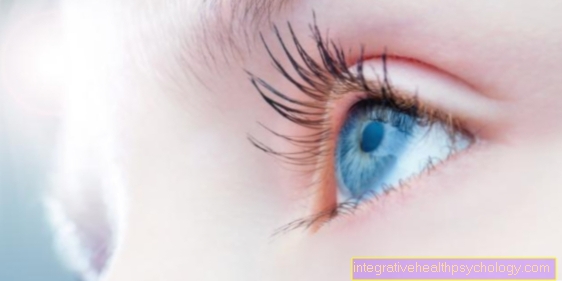Blood clotting
introduction
In our body, blood takes on, among other things, the exchange and transport of oxygen, the supply of tissue and organs with nutrients and the transmission of heat. It is constantly circulating through the body. Since it is liquid, there must be an opportunity in the event of an injury to stop the flow of blood at the injury site. This task is carried out by what is known as blood coagulation.
In medical terminology, blood clotting is also called Hemostasis designated. Become through them major blood loss from the body avoided. This is one complex process of multiple reactions, with many different factors playing an important role. In addition to a distinction between primary (cellular) and secondary (plasmatic) Blood clotting, the secondary blood clotting turns into one again intrinsic (internal) and extrinsic (external) path assigned. Both lead through different Chain reactions to the Stopping the flow of blood. Above all they are Platelets involved.

Intrinsic blood clotting
The intrinsic blood clotting is part of plasmatic blood coagulation. It is imagined stable network made of fibrinwhich stops the bleeding. This requires the activation of various factors. First the platelets are activated. These activation takes place through the contact of Platelets and one negatively charged surfacewhich usually consists of collagen or foreign material such as glass (e.g. when taking a blood sample). The activated platelets then cause the conversion of the inactive factor XII in the active state. The active factor XII now activates Factor XI and so the coagulation cascade takes its course. This cascade always runs according to the same scheme.
For the time being, the last factor in intrinsic coagulation is this Factor IX. This activates together with others Factors like VIII the final stretch of this coagulation path. The common end route of the two activation pathways form the activated factors X, V and calcium. This complex activates the Factor IIalso called thrombin. Through this will eventually Fibrinogen in fibrin converted, which is now cross-linked and a Fibrin mesh forms. Stay in this web through the blood flow Platelets and also Erythrocytes hang. So eventually becomes one Injury closed. By contraction of actin and myosin fibers in the platelets, the wound is also pulled together and the bleeding is stopped even further. This is part of primary blood clotting.
Extrinsic blood clotting
The extrinsic coagulation basically leads to the same result as the intrinsic one. Only the activation of the coagulation cascade is different.When tissues or vessels are injured, the inactivated factor III activated. This substance resides in the tissue and eventually activates the tissue Factor VII. The activated factor VII eventually forms one Complex with calciumwho then the Factor X activated. So we are already at the common end stretch of coagulation. Finally, there are several intermediate steps fibrin produced. As already described, this forms after a few minutes Blood clots, So a thrombusthat is made up of different cells of the blood like Platelets and Erythrocytes consists.
The Fibrin scaffold is used to close the wound and stop bleeding. It should therefore be the not obstruct normal blood flow and will come back after a while reduced. This process is called Fibrinolysis and referred to by an enzyme called Plasmin promoted. This enzyme is also under a control and is in turn inhibited by other substances so that it does not become one excessive fibrin dissolution comes. Through the interaction of various substances, the body ensures that it can stop minor bleeding in the event of injuries.
Bleeding disorders
Like every system in our body, the coagulation system can be different Disruptions exhibit. Since coagulation depends on many factors and substances in the tissue or blood, it is particularly important that there are no irregularities. At the same time, however, the coagulation cascade is also very strong prone to failure. Depending on which factor is affected by a disorder, the coagulation can be influenced more or less. This depends on the Severity of the disorder. Two malfunctions are explained in more detail below.
For more information on this topic, see Bleeding disorder
Factor 5 suffering
The factor V (5) plays an important role in the coagulation cascade. After its activation, it collides with the activated one Factor X the Formation of the fibrin so that if there is an injury, the bleeding through a Fibrin mesh is stopped first. This factor V can be affected by a mutation, i.e. a defect in the DNA. In medical terminology, this disorder is referred to as a Factor V Leiden mutation. It's about one inheritable defect, which is one of the most common congenital disorders in the coagulation system. This disruption causes factor V in its activity no longer stopped can be. Usually he gets through a Protein (protein C) split, as a result of which it loses its function and coagulation is stopped again. If this mechanism no longer works, the factor V works continuously further. In the end, this means that the entire coagulation with one higher activity expires as normal. As a result, the Blood thicker becomes. Thicker blood hides them dangerthat more often Blood clots form.
The affected patients are therefore at an increased risk of blood clots. In medicine this is also called Thrombophilia designated. The blood clot, too Thrombi called, arise predominantly in the Veins and this can clog what to Weakness in the affected area or a headache can lead. This process is also called thrombosis designated. Thrombosis in the legs can Pain and Swelling cause. In addition, there is then the risk that the blood clot and other vessels will come off lung or in Clogged brain. A Pulmonary embolism or one stroke are the following possible consequences. The disease is often treated when there is an increased risk of thrombosis blood thinning drugs. This is how the blood becomes more fluid held and the likelihood of blood clots decreases.
Blood clotting too much
If the blood clotting is too weak, bleeding will last longer than normal. It takes more time for the body to stop the bleeding. If, on the other hand, it is too strong, the coagulation takes place more intensely. Too much blood clotting can have different causes. Two of them have already been explained in detail. But they can also be responsible for such changes Blood composition, the Blood flow and also Changes to the vessel walls be. So there can be a mismatch between coagulant and anticoagulant factors come. Patients who have a congenital or acquired tendency to clot are increased Risk of thrombosis exposed. You are more prone to developing a blood clot, which has serious consequences like one Pulmonary embolism may have.
Redeems itself Blood clots can it can be carried through the bloodstream to the lungs and there Block the vessel. Those affected suffer from sudden onset of chest pain and shortness of breath. Blood clots can also in arteries arise. Especially when there are constrictions due to vascular calcification. Arterial blood clots can flow into and around vessels in the brain Case of closure to a stroke to lead.
For more information on various faults, see Bleeding disorder
Drugs affect blood clotting
The blood can clot through various drugs to be influenced. A distinction is made here first two large groups of drugs that are used specifically to influence coagulation.
On the one hand, there are anticoagulant drugs. They are also called Anticoagulants designated. These include, for example Vitamin K antagonists (Marcumar®), aspirin and Heparins. They do a delayed blood clotting by starting at different points in the coagulation system. They are often used therapeutically Used to prevent blood clots.
For another, there is anticoagulant drugs how Thrombin and Vitamin K. The latter promotes the Production of the coagulation factors in the liver. An administration is only useful if there is no impairment in the production of the factors or in the absorption of the vitamin via the intestine. There are also a number of drugs that are called side effect can interfere with blood clotting.
Blood clotting during pregnancy
Through the hormonal changesThat a woman goes through during pregnancy can too Changes in blood clotting come. Often one arises increased blood clotting so that pregnant women have an increased risk, Blood clots to develop. The presence of a bleeding disorder in women of childbearing age plays an important role, as the disease is not infrequently considered Cause of a miscarriage can be considered. Most miscarriages occur in the first twelve weeks of pregnancy.
Often no clear cause can be found and they can occur more frequently in one woman. The causal connections between a bleeding disorder with an increased tendency to thrombosis and a miscarriage are not yet clarified exactly. Doctors assume that by changing the blood flow the Blood supply to the uterus is poor becomes. This disturbance of the blood flow can then become one after the egg cell has implanted Embryo rejection to lead. As a bleeding disorder due to the absence of noticeable symptoms only difficult to see a woman may have multiple miscarriages until the cause is identified. Often it is certain factors such as factor V and II that malfunction and lead to complications. Women who are pregnant or who want to have children who have a congenital or acquired bleeding disorder should therefore suffer treated become.
At Desire to have children is recommended to be treated with before pregnancy blood thinning drugs to start. Selected drugs are also administered during pregnancy. This is often referred to here anticoagulant heparin fell back as it was the Do not overcome the placenta can. This means that it is not transferred from the maternal bloodstream to that of the unborn child. Regarding therapy, there is one good advice by the attending gynecologist necessary.





